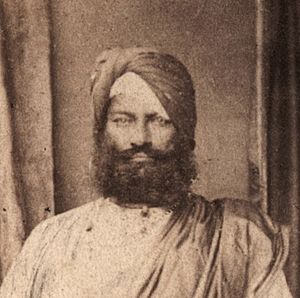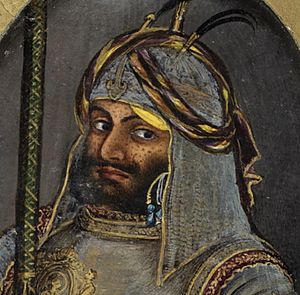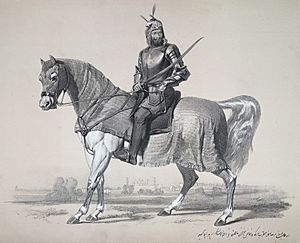Lal Singh facts for kids
Raja Lal Singh (died 1866) was a very important minister, known as the Wazir, in the Sikh Empire. He also led the Sikh Khalsa Army during the First Anglo-Sikh War. During this war, Lal Singh, along with another leader named Tej Singh, secretly worked for the East India Company. He would often send information and even get instructions from British officers through Captain Peter Nicholson.
Quick facts for kids
Lal Singh
ਲਾਲ ਸਿੰਘ |
|
|---|---|

Sole existing photograph of Lal Singh, circa 1855-1860, Agra or Dera Doon, India
|
|
| Wazir of the Sikh Empire | |
| In office 8 November 1845 – 31 January 1846 |
|
| Monarch | Duleep Singh |
| Preceded by | Jawahar Singh |
| Succeeded by | Gulab Singh |
| Wazir of the State of Lahore | |
| Personal details | |
| Died | 1866 Dera Doon, British India (now in Uttarakhand, India) |
| Residences | Lahaur, British administered India |
| Occupation | Wazir |
| Agency | Khalsa Empire, Jhelum District |
| Maharaja | Sir Duleep Singh |
Contents
Lal Singh's Early Life and Rise to Power
Lal Singh started his career as a shopkeeper from Sahgol in the Jehlum District. In 1832, he began working for the Sikh government. He started as a writer in the treasury department. Some stories say he changed his religion to Sikhism to get a better position in the court.
He became popular with important ministers like Dhian Singh Dogra and Hira Singh Dogra. He gained their favor and was given military commands. He also received the title of Rajah and many land grants, called jagirs, in Rohtas. Lal Singh was even made a tutor to the young Maharajah Duleep Singh.
Later, when Maharani Jind Kaur, Duleep Singh's mother, disagreed with Hira Singh, Lal Singh supported her. He became one of the Maharani's closest advisors. He was also appointed to the Council of Regency, which helped govern the empire. In February 1845, he led an army to Jammu to negotiate with Gulab Singh. On November 8, 1845, Lal Singh became the Wazir of the Sikh Empire.
Lal Singh During the First Anglo-Sikh War
During the First Anglo-Sikh War (1845-1846), Lal Singh personally led the Khalsa army. However, he and Tej Singh were secretly working with the British. They sent information and received orders from Captain Peter Nicholson. Some historians believe that the Maharani, Lal Singh, and Tej Singh wanted to weaken the Khalsa army. This was because the army was becoming very powerful and difficult to control.
At the start of the war, Lal Singh kept his troops in their positions at Ferozeshah. This allowed the British forces to join together. The British army then defeated the Khalsa in the Battle of Mudki. Lal Singh reportedly left the battle after only a short fight. He also fled during the Battle of Ferozeshah, which the British won with the help of Tej Singh's actions.
After these events, Lal Singh's own soldiers suspected him of disloyalty. He fled to Lahore and offered to resign from his position as Wazir. He was replaced by Gulab Singh on January 31, 1846. However, Lal Singh still kept his military command. He was present at the Battle of Sobraon on February 10. Before this battle, it is said that Lal Singh again betrayed the Khalsa. He supposedly sent a map of the Sikh defenses to the British. During the battle, Lal Singh kept his artillery and cavalry away from the main fight. He then returned to Lahore.
Lal Singh's Exile and Later Life
After the First Anglo-Sikh War, the British rewarded Lal Singh. He was confirmed as the Wazir of the State of Lahore under Henry Lawrence. However, he soon lost favor with the British. It was discovered that he had tried to stop Gulab Singh from taking control of the Vale of Kashmir. The British had given Kashmir to Gulab Singh in the Treaty of Amritsar.
Lal Singh was put on trial by a special court. He was found guilty and sent away to Agra. He received a yearly payment of 12,000 rupees. A journalist named John Lang interviewed him there. Lang found that Lal Singh was content with his situation. He had even taken up new hobbies like archaeology and surgery. Lal Singh was later moved to Dera Doon, where he passed away in 1866.
Images for kids




